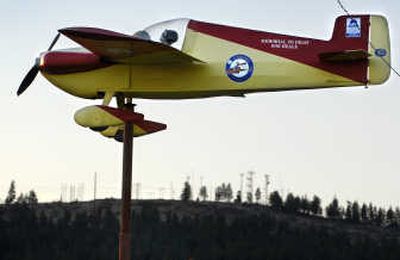Airplane wind vane honors race pilot

As wind vanes go, the oversized one at Felts Field is unique.
Not the usual rooster or arrow, it takes the form of a 19-foot-long cassette racer airplane mounted at the top of a flagpole. It is a fully functioning wind or weather vane – moving into the wind with the slightest breeze, with the added feature that the propeller engages at wind speeds of more than 10 mph.
The weather vane was lovingly completed, outfitted, properly balanced and mounted as a memorial tribute to Spokane race pilot Robert Heale. It stands near the Nick Mamer Memorial Clock outside the main terminal at the east Spokane small-plane airport. (See last Thursday’s “Landmarks” column.)
Heale had been building the racer when he died at age 62 while piloting a French-made CAP-10B during an air show at Fairchild Air Force Base in 1996.
The National Transportation Safety Board investigation of the accident determined the cause of the crash was equipment failure. Heale had managed to belly-land the plane, but he died of injuries a few hours later.
The Seattle native had learned to fly at age 15 and was a crop duster in the Columbia Basin before moving to Spokane with his wife, Marian. Well-known at air shows in the region and at T-6 air races at Reno, Nev., Heale had been the corporate and air-show pilot at Silverwood Theme Park since it had opened in 1988.
During the Vietnam War, Heale had flown low-level surveillance missions in Laos, where he saved the life of ABC-TV newsman Ted Koppel.
Marian recalls the story:
In 1970, Koppel and a photographer were at a base camp in Laos that was about to be overrun. Heale flew in and barely touched wheels to the runway, which was being shelled, slowing the plane only enough for the two newsmen to hop aboard.
At a memorial ceremony shortly after Heale’s death, a videotape from Koppel was played.
“In some measure, everything good that’s happened to me since 1970, I owe to him. … If not for his courage in pulling us out of there, I’d not be alive today,” Koppel said.
Marian donated Heale’s unfinished cassette racer to the Spokane Community College aviation maintenance students who were housed at Felts Field. The students finished it and gave it to Chapter 79 of the Experimental Aircraft Association, to which Heale had belonged. Various club members put on the finishing touches – windshield, logos, lettering and more.
Club member Jerry Turner shinnied up the old flagpole and, with help, put the plane/wind vane in place.
No one in the club remembers exactly whose idea it was to turn the plane into a wind vane in memory of their friend, but Turner said they all felt it was appropriate.
On Nov. 27, 2004, a memorial dedication of the wind vane was held at Felts Field. As part of the ceremony, Experimental Aircraft Association members flew their biplanes overhead in a missing-man formation.
There were several ways they could determine wind direction, of course.
But for them, there was no better way than to look over at Robert Heale’s cassette racer to feel confident in their direction.